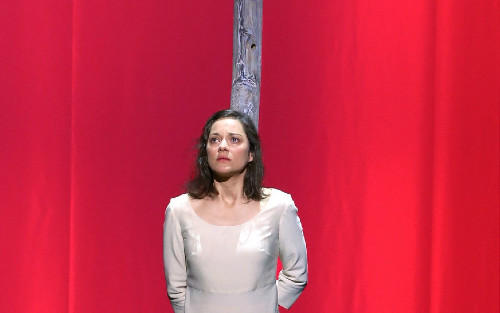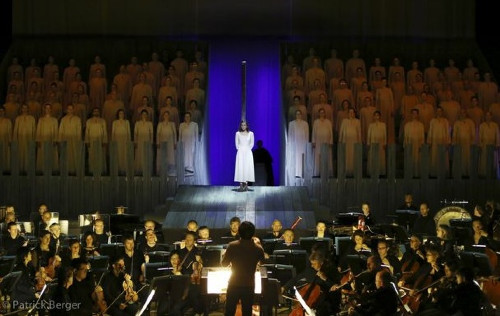Gilbert Conducts Joan of Arc at the Stake
Marion Cotilliard Simply Magnificent as Joan
By: Susan Hall - Jun 13, 2015
Joan of Arc at the Stake
By Arthur Honegger
Libretto by Paul Claudel
New York Philharmonic
Conducted by Alan Gilbert
Directed by Côme de Bellescize
Cast: Marion Cotilliard, Eric Génovèse, Christian Gonon, Erin Morley, Simone Osborne, Faith Sherman, Thomas Blondelle, Steven Humes.
New York Choral Artists, Joseph Flummerfelt, director
Brooklyn Youth Chorus, Dianne Berkun-Menaker, director
Pierre Vallet, Chorus Master.
New York, New York, June 11, 2015
Honegger had said, "My taste and effort have always been to write music which is discernible to the great mass of listeners and sufficiently free from banality to interst real enthusiasts." Claudel's text is grandiose and boisterous, mystical and powerful. Terrible puns abut the sublime.
Claudel conceived the chronology in reverse like cinema flashbacks. Time goes backward until the crucial moment when the earthly present and the spiritual come together in the devouring flames. Joan, about to die, relives in an instant the whole course of her brief existence. The stake is the point of departure and the meeting point of utter solitude of martyrdom and redemption extended to all those for whom Joan sacrificed herself.
The orchestra was submerged in the front of the hall. Action took place on raised ramps and a stage surrounding them. The chorus, standing both for Joan’s detractors and also her supporters, were mounted on two grandstands which framed the stake. Between the grandstands, an open sliver represented a pathway to earthly matters and also to heavenly ones. Pools of white and blue and blood red light bathed the sliver to reflect the emotion of the moment.
Some have criticized the Honegger score, because it is made up of so many different styles. As Gilbert conducted, each style seamlessly fit the historic scenes being depicted. Out of the primordial darkness of the Prologue and through clashes of conflict, and the flutes' color of hope and joy, to a processional Protestant hymn and Trimazo, a song of hope which Joan tries to sing before she bursts into hatcheted sobs, Honneger paints scenes with his musical pen. The New York Philharmonic, the choruses and soloists captured them all.
Honegger was known for his film scores, and clearly sensitive to the expression of emotion and visual imagery in music. He was inspired by the libretto of Paul Claudel, famous French poet, dramatist and diplomat. Had they seen Carl Th. Dreyer's The Passion of Joan of Arc? The film was made in 1928, and focuses on Joan's trial. French actress Renée Jeanne Falconetti is portrayed in close up, her eyes wild with terror and visions. The closeups in this great film are present in the magnified text and music of the Oratorio. Honegger described it as "a vast, popular fresco." We go back into a dream which is in part Joan's earthly story.
Joan is at first fearful of her imminent death, and then, in flashback, describes herself in earthly matters. By portraying her judges as animals, the her famous trial is made a travesty. Joan's point: that God is wiser than earthly men.
Gilbert brought in Côme de Bellescize, the French director, and several members of the Comédie-Française troupe to realize the stage presentation.
Joan had been canonized in 1920, five hundred years after she was burned at the stake. This Oratorio was written fifteen years later, between the first and second world wars. Joan speaks on the unification of the North and South of France. It was this vision that had sold Claudel on the project. The composer and librettist did not know if any part of France would survive. In the humor and beauty they create in words and music lies an answer: Yes, not only will France survive, but the world will as well.
Marion Cotilliard was magnificently plain as Joan. She torched our evening. From a timid girl, fearful of being burned alive, to a human being full of love and joy, Cotilliard moves perfectly with the music and the mood. Spontaneous, dramatic, profoundly emotional, and deeply-rooted in religious conviction, Cotilliard persuades us of the saint that Joan was. Her military feats are stripped away. Except for a brief story about her sword, we are dealing here with a very young penitent. She is in violent self-control.
Erin Morley, who sings the Virgin, has a lush, pure soprano which is both reverent and transfixing.
Gilbert now conducts without a baton, in clear and dynamic hand and finger movements, drawing forth excitement from the woodwinds, the brass, the ondes martenon, the cast and audience. We have come to treasure the big bang Gilbert gives us at the end of the season. He delivers again in Joan of Arc at the Stake.







